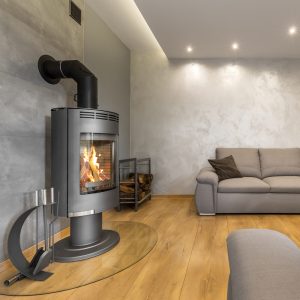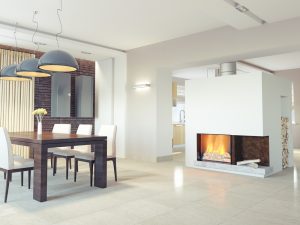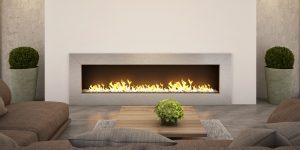How to Choose your Ideal Fireplace - our Top Tips

Choosing your ideal fireplace is a matter you’ll need to give a lot of thought to.
With winter on its way, heating is one of our biggest worries. How are we going to keep our homes nice and warm, and not get chilly on the coldest nights of the year?
Today, we’re going to talk about the things you’ll need to keep in mind when it comes to choosing the perfect fireplace to suit your needs and your home.
Fire
Fire and wood are two elements which we immediately associate with home and warmth.
Our ancestors knew the value of these elements, and came up with a way to keep themselves warm when they got back from hunting. But the campfire also became a place to socialize.
The most important meetings between tribal chiefs took place around the campfire, as well as the biggest celebrations.
Weddings, initiation ceremonies, negotiations, hunting parties and many other important events.
The campfire was not only used to keep people and the village warm, but also to warm up the heart and soul.
Today, many people dream of having a fireplace in their home. Lots of people are lucky enough to have one already, often because they live in an old country cottage.
For a long time, living in an apartment or in a small house in the city inevitably meant giving up this dream.
The good news is that the traditional heating system of fire and wood has evolved, adopting new methods which can be adapted to all types of houses.
It’s therefore important that you keep the following pieces of advice in mind:
1. Location of the fireplace
One of the first things you’ll need to think about when choosing your fireplace is where you’re going to put it.
Remember, this is a heating system, so its main aim is to keep the room warm. Although it’s also a decorative element, don’t forget your priorities.
Remember to consider the size of the room. Keeping a room warm is not the same as keeping a whole house warm.

The size of the room will influence the type of fireplace you need.
2. Measuring
We’ve said it before – measuring is f-u-n-d-a-m-e-n-t-a-l. In the world of decorating and interior design. Proportions are important if you want to have a balanced room.
For that, you’ll need to keep in mind the amount of space available for your fireplace, as well as for all the other elements in the room, like the furniture.
Remember, all fireplaces need to be installed, and some will even require some building work, so having the right measurements is fundamental. It’s also good to think of the long-term.
Choosing the right type of fireplace
You’re almost certainly thinking about buying a traditional fireplace for your home – with an open fire and the crackle of burning wood.
Nowadays, however, there are many different types of fireplaces, to match everyone’s needs and expectations.
Fireplaces are classified according to design and fuel type. Next, let’s take a look at the differences between these types.
Fuel types:
- Wood fireplaces: the traditional fireplace, wood fireplaces will last a lifetime. With this open fireplace, you’ll need a poker to tend the fire.
These fireplaces are beautiful, but looks aren’t everything. The biggest downside with this type of fireplace is how inefficient they are. Because they’re open, the heat escapes more quickly than it does from other fireplaces.
Another problem is how expensive it can be to buy firewood if you don’t happen to have your own supply.
Plus, they need to be rigorously maintained. The residue – mainly gas and ash -from this type of fuel can be harmful if you don’t clean your fireplace properly.

- Gas fireplaces: you could say that this type of fireplace is the modern version of the wood fireplace.
Gas fireplaces eliminate the inconvenience of using firewood. In its place, they use pebbles, or ceramics designed to imitate wood.
All you need is a pilot light to light the fire. The real advantage is that you have the look of a fireplace, without really creating any harmful residue.
The main disadvantage is that they can be more expensive, and don’t stay warm for long once turned off.
- Electric fireplaces: a modern fireplace that doesn’t require any building work or gas lines. The majority are portable and only need to be connected to the electricity mains.
Visually, you’ve also got the look of a traditional fireplace, even if it isn’t real. Plus, they don’t even need a chimney.
- Bio-ethanol fireplaces: bio-ethanol fireplaces are the cleanest, most efficient, and most environmentally friendly of all. They don’t emit any gas or smoke.
They’re also surprisingly versatile in their design and in their portability.
- Pellet stoves: pellet stoves use an ecological, biodegradable fuel. They’re also highly efficient.
Design
Choosing the right fireplace doesn’t just mean choosing one that will keep you warm in winter. It also means choosing a fireplace that looks great. However, the functionality should always take priority.
- Built-in fireplaces
- Floor-to-ceiling fireplaces: these need no building work, they simply need to be installed.
- Enclosed fireplaces: these have a ceramic glass door. They are safer than most other fireplaces and retain heat well.
- Portable fireplaces: these are usually electric and use bio-ethanol fuel. They usually come in bolder, more modern designs.

Conclusion
As you can see, choosing the right fireplace is no easy task. We suggest that you talk to a professional who can give you more advice, and help you with the selection and installation of your fireplace.
Remember that maintenance is essential, so choose one that’s easy to look after.
Choosing your ideal fireplace is a matter you’ll need to give a lot of thought to.
With winter on its way, heating is one of our biggest worries. How are we going to keep our homes nice and warm, and not get chilly on the coldest nights of the year?
Today, we’re going to talk about the things you’ll need to keep in mind when it comes to choosing the perfect fireplace to suit your needs and your home.
Fire
Fire and wood are two elements which we immediately associate with home and warmth.
Our ancestors knew the value of these elements, and came up with a way to keep themselves warm when they got back from hunting. But the campfire also became a place to socialize.
The most important meetings between tribal chiefs took place around the campfire, as well as the biggest celebrations.
Weddings, initiation ceremonies, negotiations, hunting parties and many other important events.
The campfire was not only used to keep people and the village warm, but also to warm up the heart and soul.
Today, many people dream of having a fireplace in their home. Lots of people are lucky enough to have one already, often because they live in an old country cottage.
For a long time, living in an apartment or in a small house in the city inevitably meant giving up this dream.
The good news is that the traditional heating system of fire and wood has evolved, adopting new methods which can be adapted to all types of houses.
It’s therefore important that you keep the following pieces of advice in mind:
1. Location of the fireplace
One of the first things you’ll need to think about when choosing your fireplace is where you’re going to put it.
Remember, this is a heating system, so its main aim is to keep the room warm. Although it’s also a decorative element, don’t forget your priorities.
Remember to consider the size of the room. Keeping a room warm is not the same as keeping a whole house warm.

The size of the room will influence the type of fireplace you need.
2. Measuring
We’ve said it before – measuring is f-u-n-d-a-m-e-n-t-a-l. In the world of decorating and interior design. Proportions are important if you want to have a balanced room.
For that, you’ll need to keep in mind the amount of space available for your fireplace, as well as for all the other elements in the room, like the furniture.
Remember, all fireplaces need to be installed, and some will even require some building work, so having the right measurements is fundamental. It’s also good to think of the long-term.
Choosing the right type of fireplace
You’re almost certainly thinking about buying a traditional fireplace for your home – with an open fire and the crackle of burning wood.
Nowadays, however, there are many different types of fireplaces, to match everyone’s needs and expectations.
Fireplaces are classified according to design and fuel type. Next, let’s take a look at the differences between these types.
Fuel types:
- Wood fireplaces: the traditional fireplace, wood fireplaces will last a lifetime. With this open fireplace, you’ll need a poker to tend the fire.
These fireplaces are beautiful, but looks aren’t everything. The biggest downside with this type of fireplace is how inefficient they are. Because they’re open, the heat escapes more quickly than it does from other fireplaces.
Another problem is how expensive it can be to buy firewood if you don’t happen to have your own supply.
Plus, they need to be rigorously maintained. The residue – mainly gas and ash -from this type of fuel can be harmful if you don’t clean your fireplace properly.

- Gas fireplaces: you could say that this type of fireplace is the modern version of the wood fireplace.
Gas fireplaces eliminate the inconvenience of using firewood. In its place, they use pebbles, or ceramics designed to imitate wood.
All you need is a pilot light to light the fire. The real advantage is that you have the look of a fireplace, without really creating any harmful residue.
The main disadvantage is that they can be more expensive, and don’t stay warm for long once turned off.
- Electric fireplaces: a modern fireplace that doesn’t require any building work or gas lines. The majority are portable and only need to be connected to the electricity mains.
Visually, you’ve also got the look of a traditional fireplace, even if it isn’t real. Plus, they don’t even need a chimney.
- Bio-ethanol fireplaces: bio-ethanol fireplaces are the cleanest, most efficient, and most environmentally friendly of all. They don’t emit any gas or smoke.
They’re also surprisingly versatile in their design and in their portability.
- Pellet stoves: pellet stoves use an ecological, biodegradable fuel. They’re also highly efficient.
Design
Choosing the right fireplace doesn’t just mean choosing one that will keep you warm in winter. It also means choosing a fireplace that looks great. However, the functionality should always take priority.
- Built-in fireplaces
- Floor-to-ceiling fireplaces: these need no building work, they simply need to be installed.
- Enclosed fireplaces: these have a ceramic glass door. They are safer than most other fireplaces and retain heat well.
- Portable fireplaces: these are usually electric and use bio-ethanol fuel. They usually come in bolder, more modern designs.

Conclusion
As you can see, choosing the right fireplace is no easy task. We suggest that you talk to a professional who can give you more advice, and help you with the selection and installation of your fireplace.
Remember that maintenance is essential, so choose one that’s easy to look after.







